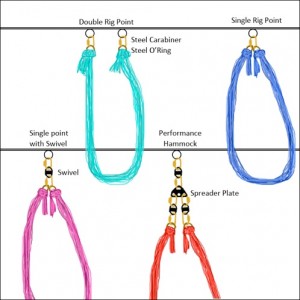I hear aerialists say all the time not to connect an aluminum carabiner to a steel carabiner, or vice versa, but no-one can explain why that is. Can you shed light on the subject?
-Philadelphia, PA
This is a hot button topic, so I’m not going to try to cover the whole thing from top to bottom. This seems to be prominent amongst “Circus” folk, and comes from a very small thing made into a big thing.
So here is some info:
The “reason” not to use Aluminum touching Steel in various applications is that there is a chemical reaction between the two that will cause the chemically weaker Aluminum to degrade faster than the Steel.
That being said:
— When I heard of this, I asked an Engineer and a man who’s expertise is Metallurgy (who was brought in special by NASA to evaluate why the Space Shuttle blew up) and both told me there is “no risk unless your equipment has been sitting together at the bottom of the ocean for 1000 years or so”.
–Steel and Aluminum are used together in building Airplanes and Submarines… two of the highest Safety Regulated things on the planet.
–I work for a “Big Company” and we have from 300-600 pages of inspections we perform each week on our Rigging equipment due to Liability and a High Safety Practices Standard. We don’t have one page of documentation that says not to use Steel and Aluminum together, nor has it ever been raised as a concern.
–I have not been able to find any documentation from the Manufacturers (Petzel, Black Diamond, Rock Exotica…etc) that states any sort of warning indicating any risk in using Steel and Aluminum in conjunction. These companies have to make equipment to ANSI standards, and are overwhelmingly documented on every aspect of their equipment. If it was a credible concern, wouldn’t there be a red flag on the equipment that states so? Feel free to contact any manufacturer, they are required to provide you specs on their equipment and any hazards related to their use.
— ENTIRE ROCK CLIMBING AND RESCUE, Military, Firemen, and Rope Access Industry… World wide… For decades… Uses aluminum and steel equipment…millions of times a year… To safeguard and rescue people. There are 100x more rock climbers and ropes rescue people than there are circus people. An entire industry… That is regulated by ANSI standards (acrobatic rigging is not). Are to believe that they have simply missed the memo on this issue?
As long as you are using it within its limits, any piece of equipment (steel or aluminum) should be expected to work as intended.
As a side note:
-Your Swivels that you hang from… those are Steel shafts and ball-bearings in an Aluminum Casing.
-Your Aluminum Auto Lock carabiners… the springs that cause them to lock are made of Steel.
– your Rescue Pulleys you hang from, those are Aluminum bodies with a Steel shaft the Pulley rolls on.
Take a look at your own equipment, I bet you can find more.
As for just using steel equipment:
Steel is stronger, but more expensive. Aluminum equipment is more prevalent and widely used successfully in millions of applications each year. It’s lighter, doesn’t rust, and made to be strong. You may encounter a facility or employer that requires you to use nothing but steel. That being the case, you have to do what they say. I believe that the Aerial Rigging inspector I spoke with in New York required that our theatre show use Steel Auto locking carabiners, but upon looking at the written standards, it was not indicated as such the document provided.
~Fred Ropes
Comments (carried over from previous website)
I use aluminum biners on steel eyelets quite often in my performances and here is what happens. The harder steel will dent the aluminum on the first hang and over many performances the friction between the harder steel and the softer aluminum will cause the dent to worsen and cause metal burs on the edges of that wear point. after many performances and practices I still haven’t needed to take them out of service but I am more mindful of which biners I run ropes through and which biners I use for steel contact. ~Trevor Gash, Edmonton, Alberta
Any roofer will tell you not to put two different metals together because you will have problems, after several decades. But the notion that you can’t combine steel and aluminum carabiners in a circus rigging is an example of a little knowledge being a dangerous thing. ~Dave Gillies, Founder, Director, Performer at The Give and Take Jugglers






